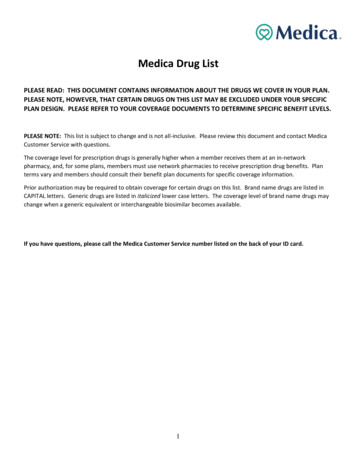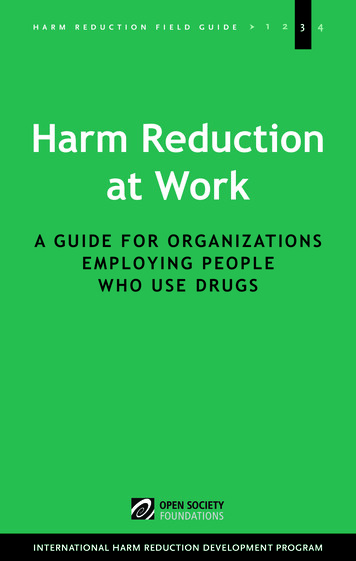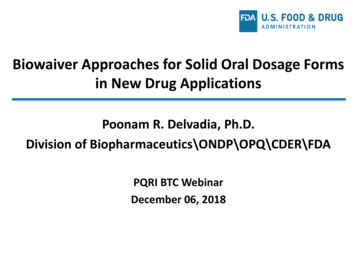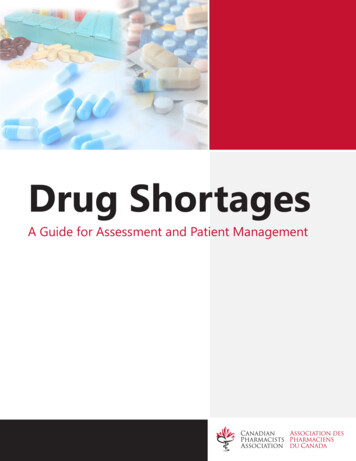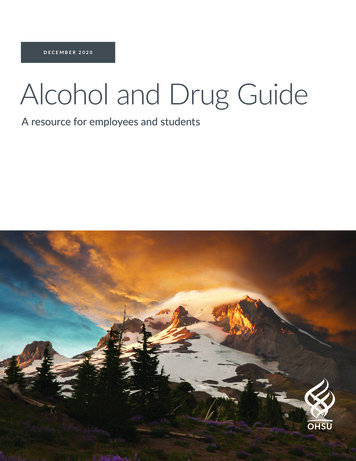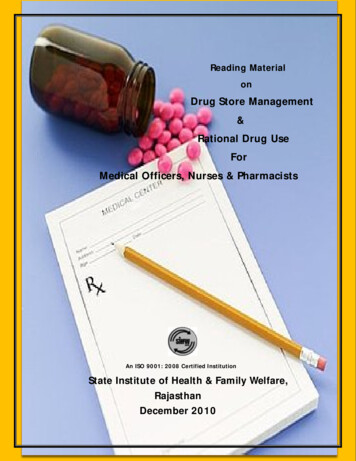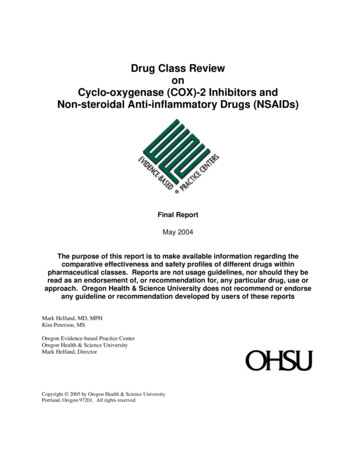
Transcription
Drug Class ReviewonCyclo-oxygenase (COX)-2 Inhibitors andNon-steroidal Anti-inflammatory Drugs (NSAIDs)Final ReportMay 2004The purpose of this report is to make available information regarding thecomparative effectiveness and safety profiles of different drugs withinpharmaceutical classes. Reports are not usage guidelines, nor should they beread as an endorsement of, or recommendation for, any particular drug, use orapproach. Oregon Health & Science University does not recommend or endorseany guideline or recommendation developed by users of these reportsMark Helfand, MD, MPHKim Peterson, MSOregon Evidence-based Practice CenterOregon Health & Science UniversityMark Helfand, DirectorCopyright 2005 by Oregon Health & Science UniversityPortland, Oregon 97201. All rights reserved
Final ReportDrug Effectiveness Review ProjectTABLE OF CONTENTSIntroduction4MethodsLiterature SearchStudy SelectionData AbstractionValidity Assessment66677ResultsKey Question 1. In head-to-head comparisons, are there differencesin effectiveness or safety between different COX-2 inhibitors?78Key Question 2. Are there differences in effectiveness between coxibs,and other NSAIDs?11Key Question 3. Are there clinically important differences insafety or adverse effects between coxibs, other NSAIDs, and the combinationof a nonselective NSAID plus antiulcer medication?12Key Question 4. Are there subgroups of patients based on demographics,other medications,or co-morbidities for which one medication is moreeffective or associated with fewer adverse effects?21Summary21References24TablesTable 1. One year risk of GI bleeding due to NSAID (in text)Table 2. Rofecoxib vs. celecoxib in chronic osteoarthritis of the knee (in text)Table 3. Head to head efficacy comparisons at 6 weeks (in text)Table 4. Trials of celecoxib versus NSAIDs (in text)Table 5. Efficacy in trials of celecoxib versus NSAIDsTable 6. Efficacy in trials of rofecoxib versus NSAIDsTable 7. Efficacy in trials of NSAIDs versus NSAIDsTable 8. Comparison of the VIGOR and CLASS trialsTable 9. Re-analysis of the CLASS and VIGOR Trials (in text)Table 10. Tolerability in randomized controlled trialsTable 11. Tolerability in trials of melocoxicam versus NSAIDTable 12. Strength of evidence by key question (in text)489113537394018414721NSAIDsUpdate #2Page 2 of 65
Final ReportDrug Effectiveness Review ProjectEvidence TablesEvidence Table 1. Characteristics and results of head to head randomizedcontrolled trials of coxibsEvidence Table 1a. Quality assessment of head to head randomized controlledtrials of coxibs52AppendicesAppendix A.Appendix B.Appendix C.Appendix D.54555862NSAIDs selectivitySearch strategyMethodsExcluded trial publicationsFiguresFigure 1. Results of Literature Search4965This report has not been reviewed or approvedby the Agency for Healthcare Research and QualityRecommended citation for this report: Helfand M, Peterson K, Carson SM. Drug Class Review on NSAIDs.Final Report: ments/NSAIDs Final Report u2.pdf 2004NSAIDsUpdate #2Page 3 of 65
Final ReportDrug Effectiveness Review ProjectINTRODUCTIONCompared with placebo, non-steroidal anti-inflammatory drugs (commonly calledNSAIDs) reduce pain significantly in patients with arthritis,1 low back pain,2 minor injuries, andsoft tissue rheumatism. However, NSAIDs have important adverse effects, includinggastrointestinal (GI) bleeding,3 peptic ulcer disease, hypertension,4 edema, and renal disease.NSAIDs reduce pain and inflammation by blocking cyclo-oxygenases (COX),enzymes that are needed to produce prostaglandins. Most NSAIDs block two differentcyclo-oxygenases, called COX-1 and COX-2. COX-2, found in joint and muscle,contributes to pain and inflammation.NSAIDs cause bleeding because they also block the COX-1 enzyme, whichprotects the lining of the stomach from acid. In the US, complications from NSAIDs areestimated to cause about six deaths per 100,000 population, a higher death rate than thatfor cervical cancer or malignant melanoma.5 A risk analysis6 based on a retrospective casecontrol survey of emergency admissions for upper GI disease in two UK general hospitalsprovided useful estimates of the frequency of serious GI complications from NSAIDs.7 In peopletaking NSAIDs, the 1-year risk of serious GI bleeding ranges from 1 in 2,100 in adults under age45 to 1 in 110 for adults over age 75, and the risk of death ranges from 1 in 12,353 to 1 in 647:Table 1. One year risk of GI bleeding due to NSAIDAge range (years)Chance of GI bleed due to NSAIDChance of dying from GIbleed due to NSAIDRisk in any one year is 1 in:16-45210045-6464665-74570 75110768Data are from Blower, recalculated in Moore and in Bandolier12,35338003353647NSAIDs differ in their selectivity for COX-2—how much they affect COX-2relative to COX-1. An NSAID that blocks COX-2 but not COX-1 might reduce pain andinflammation in joints but leave the stomach lining alone. Appendix A9 summarizes the NSAIDsand their selectivity based on assay studies (done in the laboratory instead of in living patients).The table gives an idea of how widely NSAIDs vary in their selectivity, but should be interpretedwith caution. Different assay methods give different results, and no assay method can predictwhat will happen when the drug is given to patients. Clinical studies, rather than these assaystudies, are the best way to determine whether patients actually benefit from using more selectiveNSAIDs.Scope and Key Questions1. In head-to-head comparisons, are there differences in effectiveness or safetybetween different COX-2 inhibitors?2. Are there differences in effectiveness between coxibs and other NSAIDs?3. Are there clinically important differences in safety or adverse effects betweencoxibs, other NSAIDs, and the combination of a nonselective NSAID plus antiulcermedication?4. Are there subgroups of patients based on demographics, other medications, orNSAIDsUpdate #2Page 4 of 65
Final ReportDrug Effectiveness Review Projectco-morbidities for which one medication is more effective or associated withfewer adverse effects?Several aspects of the key questions merit comment:1. Patients. We focused on patients with chronic pain from osteoarthritis,rheumatoid arthritis, soft-tissue pain, or back pain. We included ankylosingspondylitis. COX-2 inhibitors are also used to treat dysmenorrhea and acutepain (e.g., dental or surgical pain), and to prevent the formation of colorectalpolyps. We did not examine studies of the use of coxibs for these indications.2. Efficacy. The main efficacy measures are pain, functional status, anddiscontinuations due to lack of efficacy. Measures vary among studies.Frequently used measures are:Visual analogue scale (VAS): The patient indicates their level of pain, function,or other outcome by making a mark on a scale labeled with numbers (such as 0 to100) or descriptions (such as “none” to “worst pain I’ve ever had”).The Western Ontario and McMaster Universities Osteoarthritis Index (WOMAC)is a 24-item questionnaire used to assess the functional status of patients withosteoarthritis of the knee and hip. A lower score indicates better function.Patient Global Assessment of Disease Status and Investigator Global Assessmentof Disease Status. The patient or investigator answers questions about the overallresponse to treatment, functional status, and pain response, using a VAS or Likertscale.American College of Rheumatology (ACR) criteria measure disease activity andresponse to treatment. ACR 20, ACR 50, or ACR 70 reflect either animprovement to the 20%, 50%, or 70% level in the parameters outlined.3. Safety and adverse effects. The following events were included in thereview:a. Serious GI events (GI bleeding, symptomatic ulcer disease, perforationof the GI tract, and death).b. Serious cardiovascular events (myocardial infarction, angina, stroke,transient ischemic attack, cardiovascular death, and related measures).c. Tolerability and adverse events. We recorded discontinuation due toany adverse event, any serious adverse event, the overall rate of adverseevents, the rate of GI adverse events, and the combined rate of adverseevents related to renal and cardiovascular function, including increasedcreatinine, edema, hypertension, or congestive heart failure. We alsorecorded the frequency of, and discontinuations due to, abnormallaboratory tests, primarily elevated transaminases (liver tests).Several types of adverse events were excluded:d. The main non-clinical, or intermediate, outcome measure for GIadverse effect is endoscopic ulcer. Ulcers in the stomach or smallintestine can be seen in up to 40% of patients taking NSAIDs.10, 11As many as 85% of these ulcers can only be found by endoscopybecause they do not cause symptoms or bleeding. All three COX-2inhibitors in the US market significantly reduce the incidence of theseasymptomatic ulcers. Based on input from the subcommittee, we didNSAIDsUpdate #2Page 5 of 65
Final ReportDrug Effectiveness Review Projectnot include endoscopic ulcer as an outcome measure, since our focus ison clinically significant adverse events.e. Case reports.i. Aseptic meningitis. Near the end of March 2002, the Food andDrug Administration announced that rofecoxib use had beenlinked to seven cases of aseptic meningitis reported to theFDA’s Spontaneous Reporting System. Authors from the FDApublished an article reporting five of the cases.12ii. New case reports. The May, 2003 searches identified 38 casereports involving the following adverse events:a. Celecoxib: anaphylaxis,13 fatal14 and nonfatal allergicvasculitis,15, 16 interstitial nephritis with17and without18 nephritic syndrome, cholestatic hepatitis,19 toxicepidermal necrolysis,20-23erythema multiforme,24 migratory pulmonary infiltrates,25 acutepancreatitis,26 torsade depointes,27 and renal papillary necrosis.28b. Rofecoxib: wrinkled palms,29 acutepancreatitis,30 acute colitis,31-33 cholestatic hepatitis,34 fatal35 andnonfatal hyperkalemia,36fatal pulmonary hemorrhage,37 erythema multiforme,38 acuteinterstitial nephritis,39 and gynecomastia.404. Drugs. We sought evidence about currently available coxibs (celecoxib [SC58635], rofecoxib [MK 0966], valdecoxib) and NSAIDs.METHODSLiterature SearchTo identify articles relevant to each key question, we searched the CochraneDatabase of Systematic Reviews (4th quarter, 2003), EMBASE (1st quarter, 2004),MEDLINE (1996 to January, week 1 2004), and Premedline. We used broad searches, onlycombining terms for drug names with terms for relevant research designs (see Appendix B forcomplete search strategy). Other sources of citations were EULAR 2001 abstracts, Bandolierand reference lists of review articles. Pharmaceutical manufacturers were invited to submitdossiers, including citations, using a protocol issued by the Center for Evidence-based a/Final Submission Protocol Ver1 1.pdf). Allcitations were imported into an electronic database (EndNote 6.0).Study SelectionWe included randomized controlled trials of at least 4 weeks’ duration thatcompared a coxib or other NSAID with an active control group. We excludedtrials in healthy volunteers and those that had only a placebo control group.In contrast with many other drug classes, clinical trials of COX-2 inhibitors areNSAIDsUpdate #2Page 6 of 65
Final ReportDrug Effectiveness Review Projectoften designed to assess adverse events. We also identified several observational studiesthat assessed adverse event rates, but we excluded them as these offered no advantageover the randomized trials.Data AbstractionOne reviewer abstracted the following data from included trials: study design,setting, population characteristics (including sex, age, ethnicity, diagnosis), eligibility andexclusion criteria, interventions (dose and duration), comparisons, numbers screened,eligible, enrolled, and lost to followup, method of outcome ascertainment, and results foreach outcome. We recorded intention-to-treat results if available.Validity AssessmentWe assessed the internal validity (quality) of systematic reviews and randomizedtrials based on the predefined criteria listed in Appendix C. These criteria are based on thosedeveloped by the US Preventive Services Task Force and the National Health ServiceCentre for Reviews and Dissemination (UK).41, 42 We rated the internal validity of each trialbased on the methods used for randomization, allocation concealment, and blinding; thesimilarity of compared groups at baseline; maintenance of comparable groups; adequatereporting of dropouts, attrition, crossover, adherence, and contamination; loss to followup; andthe use of intention-to-treat analysis. Trials that had a fatal flaw in one or more categories wererated poor quality; trials which met all criteria were rated good quality; the remainder were ratedfair quality. As the “fair quality” category is broad, studies with this rating vary in their strengthsand weaknesses: the results of some fair-quality studies are likely to be valid, while others areonly probably valid. A “poor quality” trial is not valid—the results are at least as likely to reflectflaws in the study design as the true difference between the compared drugs. External validity oftrials was assessed based on whether the publication adequately described the study population,how similar patients were to the target population in whom the intervention will be applied, andwhether the treatment received by the control group was reasonably representative of standardpractice. We also recorded the funding source and role of the funder.Overall quality ratings for an individual study were based on ratings of theinternal and external validity of the trial. A particular randomized trial might receive twodifferent ratings: one for efficacy and another for adverse events. The overall strength ofevidence for a particular key question reflects the quality, consistency, and power of theset of studies relevant to the question.RESULTSOverviewSearches identified 748 publications: 135 from the Cochrane Library, 78 from MEDLINE, 421from EMBASE and 114 from the combination of other sources listed above. 66 were included inthe review. We included 49 randomized controlled trials, 5 systematic reviews and 2observational studies. An additional 14 publications provided background information,including 8 meta-analyses. We excluded 72 publications for the reasons detailed in Figure 1.Excluded trial publications are listed in Appendix D.NSAIDsUpdate #2Page 7 of 65
Final ReportDrug Effectiveness Review ProjectKey Question 1. In head-to-head comparisons, are there differences ineffectiveness or safety between different COX-2 inhibitors?We found six published randomized, multicenter, fair-to-good quality trials thatdirectly compared COX-2 inhibitors for osteoarthritis of the knee. 43-48 Pharmaceuticalmanufacturers were reported as funding sources in all but one study.47 Three earlier studiesfunded by the maker of celecoxib43-45, found no difference in efficacy between rofecoxib 25mgand celecoxib 200mg, but found a higher rate of adverse effects with rofecoxib. Another (VACT,for Vioxx Acetominophen Celecoxib Trial)46, conducted by the maker of rofecoxib, found thatrofecoxib 25mg was more effective than celecoxib 200mg, with no differences in rates ofadverse effects. The more recent study funded by the maker of celecoxib48found no difference ineither efficacy or adverse effects between celecoxib 200 mg and rofecoxib 25 mg (EvidenceTables 1 and 1a).Efficacy results. Rofecoxib 25 mg and celecoxib 200 mg had similar effects on patients’pain intensity, 3-hour pain relief, global assessment of efficacy and rescue medication use in afair-quality, 7-day study of 30 patients with osteoarthritis of the knee.47 Three larger trialsappeared to enroll patients with similar demographics and baseline levels of pain (see tablebelow).45, 46, 48, 49 All compared rofecoxib 25mg qd and celecoxib 200mg qd in patients with flareups of chronic osteoarthritis of the knee. All were 6-week trials.Table 2. Comparison of rofecoxib and celecoxib in flare-ups of chronic osteoarthritis ofthe kneeCharacteristicRofecoxib 25mg (n)Celecoxib 200mg (n)Aspirin 325 qd permittedMean ageMean osteoarthritis durationPercent whiteBaseline pain on walking (score)Discontinued trial by 6 wks:Rofecoxib 25mgCelecoxib 200mgMcKenna5960Yes6210.5 years80%72Geba9597No62.610 years85%72Gibofsky190189Yes62.99 yearsNR6816%22%19%17%15%16%All were probably adequately randomized and blinded, and didn’t havestatistically significant differences in baseline characteristics. However,there were some discrepancies in McKenna and Geba. In McKenna, the proportion of patientswith a past history of ulcers was higher for celecoxib (10% vs. 5%), and the proportion that had apast history of nonspecific GI symptoms was higher for rofecoxib (38% vs. 46%). Theproportion of white patients was the same in the celecoxib and rofecoxib groups (84% vs. 85%),but was lower in the placebo group (73%). In Geba, the rofecoxib 25mg group had a higherproportion of women (72.6% vs. 64.9%) and a lower proportion of white subjects (82.1% vs.87.6%) than the celecoxib 200mg group. The main article did not report the baseline WOMACand global assessment scores of patients in the different treatment groups; a response to a letterto the editor states that the baseline WOMAC scores were similar.More recently, Gibofsky hypothesized that perhaps neither McKenna nor Geba werepowered sufficiently to measure differences between celecoxib and rofecoxib. Gibofskydescribed the McKenna study as being powered only to compare active treatments with placeboNSAIDsUpdate #2Page 8 of 65
Final ReportDrug Effectiveness Review Projectand the Geba study as powered to compare rofecoxib with acetaminophen. Therefore, Gibofsky,along with some authors of the McKenna study, set out to conduct a study powered to comparecelecoxib and rofecoxib, with a sample size based on results of the McKenna study.Efficacy results are summarized in Table 3 below. Mean change in WOMAC VAS scorefor pain on walking was similar for celecoxib 200 mg and rofecoxib 25 mg across studies.Compared to celecoxib on other VAS scores reported in Geba, rofecoxib had significantly largermean reductions in Rest Pain and Night Pain and a similar mean reduction in Morning Stiffness.Similar mean VAS reductions in Arthritis Pain were seen for celecoxib and rofecoxib inMcKenna. WOMAC Composite Score results from Geba and Gibofsky are conflicting.Table 3. Head to head efficacy comparisons at 6 weeks (mean change from baseline)WOMAC VASWOMAC CompositeScoresSubscalesWalkingpainGebaRofecoxib -42Celecoxib -36.2McKennaRofecoxib -38Celecoxib -38GibofskyRofecoxib -29.2Celecoxib -31.5*p 0.05**p nPain-31.1*-23.4-36.2-29.1-32.7**-22.6nrnr-35.4* -35*-28.6 9-20.1-22.1Stiffness Function TotalGeba and his colleagues noted that, regarding the WOMAC scores, "There is nocurrent consensus on the magnitude of effects that is clinically important." A 1992consensus conference found that a difference of 15 to 20 points on a VAS for pain andglobal disease activity was "clinically significant," but this has never been validated inclinical studies.50 A more recent analysis of data from randomized trials estimated that theminimal perceptible improvement for each WOMAC scale was 11 mm.51 In the Geba trial,WOMAC scores differed by 8 points or less between celecoxib 200mg and rofecoxib 25mg.Adverse events and safety. Proportion of tolerability questionnaire ratings of “good” or“excellent” were similar for rofecoxib and celecoxib patients in the 7-day trial.47 The differencesin rates of adverse effects across the three similar trials were striking. In McKenna, morerofecoxib than celecoxib patients experienced at least one GI adverse effect (34% vs. 11%,p 0.004), most of which were mild and involved diarrhea, dyspepsia, or abdominal pain. Therewere no differences between rofecoxib and celecoxib groups in rates of diarrhea, dyspepsia, orabdominal pain in Geba or Gibofsky.It is difficult to explain the discrepancy of the adverse GI event rates in McKenna. Onepossible explanation is that McKenna's study may have included a broader spectrum of patientswith respect to previous GI disease. In McKenna, patients who had previously had ulcer diseaseor other GI disorders were permitted to enter the study, and almost 50% had at least one GIdisorder before the study began. In Gibofsky, only 7.4% had a history of either upper GINSAIDsUpdate #2Page 9 of 65
Final ReportDrug Effectiveness Review Projectbleeding or ulcer. It is not clear how many patients in Geba's study had a history of GI disorders.In contrast, concomitant aspirin use may be ruled out as another potential explanation, as bothMcKenna's and Gibofsky’s studies permitted aspirin 325mg qd and occasional use ofacetaminophen.There were no differences in the percentage of patients who discontinued therapy by 6weeks in the studies. In Geba, the proportion of patients who discontinued for lack of efficacywas 8.4% in the rofecoxib 25mg group and 9.2% in the celecoxib 200mg group (not significant).Another two head-to-head trials (SUCCESS VI and SUCCESS VII) focused onadverse events in patients 65 or older who had osteoarthritis and well-controlledhypertension.43, 44 Both of these 6-week trials compared rofecoxib 25mg qd to celecoxib 200mgqd.In the first trial,44 nearly twice as many rofecoxib-treated patients (n 399) as celecoxibtreated patients (n 412) experienced edema (9.5% vs. 4.9%, p 0.014). Systolic blood pressureincreased significantly in 17% of rofecoxib- compared with 11% of celecoxib-treated patients (p 0.032) at any study time point. Diastolic blood pressure increased in 2.3% of rofecoxibcompared with 1.5% of celecoxib-treated patients (p 0.44). At week 6, the change frombaseline in mean systolic blood pressure was 2.6 mmHg for rofecoxib compared with -0.5mmHg for celecoxib (p 0.007).In this trial, there was an important baseline difference in the proportion ofpatients who took an ACE inhibitor for hypertension (40% for celecoxib-treated patientsvs. 29% for rofecoxib-treated patients, p 0.002). Although not statistically significant, atbaseline fewer celecoxib-treated patients had angina (16.3% vs. 19.8%) or or a history ofmyocardial infarction (8% vs. 9.3%). These differences cast doubt on the quality of thetrial: unbiased randomization is unlikely to have resulted in a baseline difference thislarge.In the second trial,43 the primary endpoints were 1) systolic blood pressure 140 mm Hgor elevation of 20 or more mm Hg from baseline 2) edema and 3) change from baseline in meanblood pressure. Aspirin use was permitted. The mean age of subjects was 73 years. At baseline,fewer celecoxib-treated patients had coronary disease (15.5% vs. 12.8%), but the proportions ofpatients taking different anti-hypertensive medications were similar. The baseline differences donot suggest that there was a major flaw in randomization.A similar proportion of patients taking rofecoxib (53/543, 9.8%) and celecoxib(51/549, 9.3%) withdrew from the study because of adverse events, treatment failure, orother reasons. By 6 weeks, 14.9% of the rofecoxib patients and 6.9% of the celecoxibpatients had systolic blood pressure elevations (p 0.0001). In a subgroup analysis,rofecoxib was more likely than celecoxib to cause systolic blood pressure elevation forpatients taking an ACE inhibitor or a beta blocker, with or without a diuretic.Two head-to-head trials have been reported in abstract form but have not beenpublished fully and could not be included in this review. One,52 funded by the maker ofcelecoxib, found that rofecoxib, but not celecoxib or naproxen, induced a significant increase in24-hour ambulatory systolic blood pressure in diabetics taking ACE inhibitors. The other (VACTII), funded by the maker of rofecoxib, found no difference in clinically important hypertensionadverse events for rofecoxib and celecoxib.53NSAIDsUpdate #2Page 10 of 65
Final ReportDrug Effectiveness Review ProjectKey Question 2. Are there differences in effectiveness between coxibs and otherNSAIDs?Celecoxib vs. NSAIDS. Nearly all of the available efficacy datacomparing celecoxib to nonselective NSAIDs in osteoarthritis and rheumatoid arthritiscome from a series of trials sponsored, designed, and analyzed by the maker of celecoxib.These trials were large (536 to 1,214 subjects) and were mostly short-term. As shown inthe table, not all of these trials have been published:Table 4. Trials of celecoxib versus NSAIDsNSAIDnaproxendiclofenacibuprofenNumber of trials932Number published fullyin peer-reviewed literature621Duration6-12 weeks6-24 weeks12 weeksThe lack of complete reporting raises concern about publication bias. Forexample, of the two trials that compared celecoxib to naproxen in patients withosteoarthritis, the one that found celecoxib and naproxen to be equally effective has beenpublished.54, 55 The unpublished trial, which included 1191 subjects, found that naproxen wassuperior to celecoxib at 2 and 12 weeks.56 Data from the unpublished studies have been reported,but not in detail, in several meta-analyses sponsored by the manufacturer of celecoxib.56-61 Afterreviewing data from all the trials, the FDA found no difference in efficacy between celecoxiband nonselective NSAIDs.62 These data are not completely available for critical appraisal,however.In addition to the nine published trials in the series, there were two others. TheCLASS trial had a total of 7,968 patients randomized to celecoxib, ibuprofen, ordiclofenac.63 CLASS focused on adverse effects rather than efficacy. A higher proportion ofNSAID patients withdrew for lack of efficacy (14.8% vs. 12.6%, p 0.005), but no other efficacyresults were reported. In the other trial, there were no statistically significant differences betweencelecoxib and ketoprofen in pain control or function in 246 patients with ankylosingspondylitis.64The eleven published trials are summarized in Table 5.54, 55, 65-73 In one of the studies(Emery), randomization did not appear to result in equivalent groups; this study was rated fairto-poor while the others were rated good-quality. The published trials provide good overallevidence that celecoxib is equivalent to nonselective NSAIDs in efficacy for osteoarthritis,rheumatoid arthritis, and other soft-tissue pain.Data from some of these studies.54, 55, 65, 66, 68-70, 73, as well as two unpublished studies(Pharmacia Studies 054 and 071), were also analyzed in a good quality systematic review fundedby the makers of celecoxib.74 This review focused only on studies that were at least 12 weeks induration. Results of this review are consistent with our findings that celecoxib and NSAIDs areequally efficacious in studies of patients with osteoarthritis and rheumatoid arthritis.One meta-analysis of trials of celecoxib versus NSAIDs focused on efficacy inelderly patients.59 Celecoxib 200mg and 400mg and naproxen 1000mg were similar in efficacy.SUCCESS-1, a randomized trial of 13,274 patients with osteoarthritis, comparedcelecoxib to diclofenac and naproxen. The trial is not yet published, but the authorsreported in an abstract that there were no differences in efficacy.75-77NSAIDsUpdate #2Page 11 of 65
Final ReportDrug Effectiveness Review ProjectRofecoxib vs. NSAIDs. We were unable to determine whetherall manufacturer-sponsored trials of rofecoxib versus NSAIDs have beenpublished. The results of thirteen published trials are summarized in Table 6, where they aresorted by length of followup.10, 11, 78-87 All but one of the trials included osteoarthritis patients,and all but two83, 85 were supported by the manufacturer of rofecoxib. The published trialsprovide good overall evidence that rofecoxib is equivalent to nonselective NSAIDs in efficacyfor OA. In addition, one large, good-quality trial indicates that rofecoxib is equivalent tononselective NSAIDs in efficacy for rheumatoid arthritis.Valdecoxib vs. NSAIDs. In clinical trials submitted to the FDA,valdecoxib was as effective as ibuprofen (800mg 3 times/day), diclofenac (75mg twicedaily), and naproxen (500mg twice daily) in treating osteoarthritis symptoms. Threepublished trials found no difference in efficacy between valdecoxib and naproxen.88-90 A fourthtrial found no difference in efficacy between valdecoxib 20-40 mg and diclofenac 75 mg slowrelease in treating rheumatoid arthritis.91NSAID vs NSAID. In double-blinded trials of meloxicam 7.5mg, 15mg, and 25mgversus other NSAIDs (Table 7) there were generally no differences in efficacy.92-100 In two of thetrials, however, patients taking nonselective NSAIDs were significantly less likely to withdrawdue to lack of efficacy than patients taking meloxicam.94, 99Several recent good-quality systematic reviews by the Cochrane Collaboration found noclear differences among nonselective NSAIDs in efficacy for treating knee,101 back,2 or hippain.102 These reviews did not include the COX-2 inhibitors.Key Question 3. Are there clinically important differences in safety or adverseeffects between coxibs, other NSAIDS, and the combination of anonselective NSAID plus antiulcer medication?Significant GI events (GI bleeding, hospitalization for GI bleeding,symptomatic ulcer disease, perforation of the GI tract, and death).Coxibs. Three trials were sufficiently large to evaluate complications ofpeptic ulcer disease as a primary endpoint. The CLASS trial evaluated celecoxib versusibuprofen and diclofenac;63 the VIGOR trial evaluated rofecoxib versus naproxen.81 The thirdtrial compared celecoxib to the combination of dicoflenac plus omeprazole in patients whopresented with a bleeding ulcer.103 There are no trials of valdecoxib in this category.VIGOR (Vioxx G
NSAIDs differ in their selectivity for COX-2—how much they affect COX-2 relative to COX-1. An NSAID that blocks COX-2 but not COX-1 might reduce pain and . (including sex, age, ethnicity, diagnosis), eligibility and exclusion criteria, interventions (dose and duration), comparisons, numbers screened, eligible, enrolled, and lost to followup .


